What is the prone position?
Prone position is one in which a person is lying on their abdomen with the face down and the back up.
Supine vs prone position
A patient in prone position is positioned on their abdomen, face down, with the back up, while a patient in supine position is lying on their back, face up, with legs and spine aligned.
Why would a patient need to be in the prone position?
Prone positioning is used to help improve oxygenation in clients with severe acute respiratory distress syndrome (ARDS) and refractory hypoxemia.
Other situations where a patient may be positioned prone are certain surgeries (to allow better access to the surgery site), alternating positions to prevent pressure ulcers, and some physical therapy exercises.
Contraindications for prone positioning
- Spinal instability
- Unstable fractures (pelvic, facial)
- Raised intracranial pressure
- Anterior burns
- Chest tubes
- Recent endotracheal surgery
- Pregnancy
- Shock
- Open wounds
Potential complications of prone positioning
- Nerve compression
- Dislodging tubes or catheters
- Pressure sores
- Transient reduction in oxygen saturation
- Increased intraabdominal pressure
- Venous stasis (e.g., facial edema)
- Retinal damage
- Transient arrhythmias
What is refractory hypoxemia?
Refractory hypoxemia is a severe form of low blood oxygen levels that does not adequately respond to conventional oxygen therapy, such as high-flow nasal cannula or mechanical ventilation with high levels of supplemental oxygen. Often encountered in conditions like acute respiratory distress syndrome (ARDS), it poses a significant risk of organ failure and mortality.
How does prone position improve oxygenation?
Due to gravity, fluid pools in the dependent alveoli in the lungs. Dependent alveoli are more fluid-filled than air-filled. Prone position can help expand collapsed alveoli, which increases ventilation capacity and improves oxygenation.
In the supine position, the dependent alveoli are in the back (dorsal). The heart and mediastinum add increased pressure to the lungs, which can collapse the dorsal alveoli. The added pressure in this position can increase the risk of atelectasis.
In the prone position, the dependent alveoli are in the front (ventral). The fluid can shift from back to front, giving the posterior alveoli a chance to recover.
Prone positioning is generally reserved for ventilated clients, but may be considered for non-ventilated clients meeting criteria for hypoxia. Prone positioning is most effective when started in the early stages of ARDS (within the first 36 hours).
How to prepare prone ventilation procedure
- Check for contraindications.
- Assemble sufficient team members and supplies for procedure, including team lead.
- Consider possible adverse effects of prone positioning.
- Explain the maneuver to the client and/or their family.
- Confirm placement of endotracheal tube from recent imaging.
- Inspect and confirm that the endotracheal tube and all catheters are firmly secured.
- Consider exactly how the client’s head, neck, and shoulder girdle will be supported after they are turned prone.
- Stop tube feeding, cap or clamp the feeding and gastric tubes.
- Prepare endotracheal suctioning equipment.
- Decide whether the turn will be towards right or left.
- Prepare all IV tubing and catheters for connection when the client is prone.
